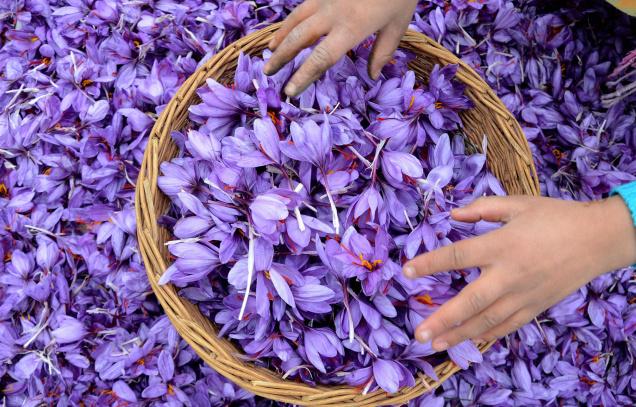International sanctions against Iran were lifted this week, but there are still many restrictions on trade between Iran and the United States. A number of Iranian products will be allowed in though, including caviar, carpets and saffron.
Eighty percent of saffron comes from Iran. As the most expensive spice in the world, it has been called the country’s “red gold.”
But there are some problems with the saffron trade. The label on the spice’s origin is often false. The saffron itself is often diluted or replaced with something else entirely. Now there’s a movement called “saffrononics” trying to improve how saffron is grown and traded.
Here & Now‘s Robin Young talks with Pat Heslop-Harrison, a professor of genetics at the University of Leicester, about the changes in the saffron trade.
Interview Highlights: Pat Heslop-Harrison
What are your concerns?
“A real concern is that people who buy the fraudulent saffron are not getting all the goodness, the aroma and the flavor.”

On the aroma of saffron
“In saffron there are three different compounds which affect three different senses of ours differently. There’s the color, which is a nice orange, but there’s also the flavor which gives us this slightly bittersweet flavor, and then the aroma of the floral vanilla notes that one has. Normally if you buy the cheap or ground saffron, the flavor and aroma won’t be there.”
What work goes into saffron production?
“Where you may get several tons of corn from an acre of land, you will only get about 2 pounds of saffron. That involves picking the crocus flowers, 100,000 or so per acre, and pulling out the stigmas, the orange parts that contain the pollen when the plant is fertilized. But it’s actually the stigmas which are the prized spice. Then it’s dried. Different countries have different traditions for the drying, which means there are slight differences depending on whether it comes from Kashmir or Iran or Greece. The color, flavor and smell may differ slightly because of the different drying processes. But basically it’s a very low heat, so either the sun or a low oven.”
How did the fraudulent market in saffron start?

“There are several different types of fraud. One is selling things that aren’t saffron and another is selling saffron as though it is produced in one country and not in another. Clearly Iran’s production has been much higher than that of any other country in the world, partially because it is unusually fitted to the climate and the availability to the labor. It does mean the Iranian saffron has been at a lower price and therefore it’s been shipped and unscrupulous people have relabeled it as coming from a different country; Spain or Greece or indeed India.”
What prompted Spain to import and relabel Iranian saffron as their own?
“It did have its own production and it still produces a few percent of the Iranian production, but people like it so much that the local production does not keep up with the demand. There wouldn’t be enough people to harvest it and pull out all of the hundreds and thousands of stigmas to sell, and the Spanish demand is huge because paella is essentially a national dish, which has a lot of its quality complimenting the seafood and rice coming from the saffron spice.”
Are there questions about the labor and how saffron is produced in Iran?
“We always like to think about the ethical production of the food. It certainly is very often done as a family activity, so I expect that a few of the children would be involved in helping. But from what I have heard I believe it is not the coerced, paid labor outside the family that is a major concern for many other products. The individual farms are relatively small, that are producing much of the saffron, as far as I have seen from talking to the farmers and the merchants.”
Why is having ‘perfect and real’ saffron so important to you?

“I enjoy saffron for use as a spice and for eating, in both savory and sweet dishes. But in my whole research project, we are interested in high value agricultural products which are good for rural development and for sustainability of agriculture. And I’m also interested in exploiting the biodiversity of all of the crops out there and looking at what their wild relatives are, where they’ve come from originally, how they’ve spread across the world and the ways that they’re used. That’s where the laboratory interest comes.”
How do you know whether saffron is fake or not?
“It’s possible to tell. For example if you use strands rather than the ground type, but then look at it very carefully and you may see that it doesn’t appear to have a strand or a feathery end to it. But some groups are selling corn silks cut into little pieces and dyed. If it looks like the true saffron then that’s a good indication. Then there’s smell, which a lot of fraudulent saffron does not have, it lacks aroma or any flavor associated with it. So the color is the big target of the fraud.”
On the sanctions being lifted?
“I’m really happy that it’s going to help distribute more of the high quality saffron that the Iranians are able to produce, and I hope that it will ensure that their agriculture and small-scale industries have something else that they will be able to distribute to us that we can appreciate both scientifically and as consumers.”













nice keep moving 😀
Iranian saffron is the best in the world. Spain and afghanistan just buy from iran and sell it again with different package!!